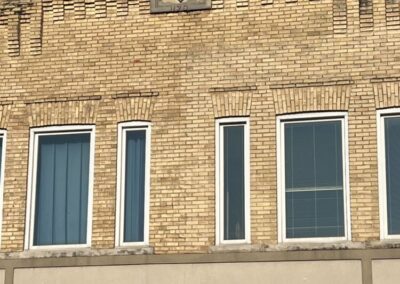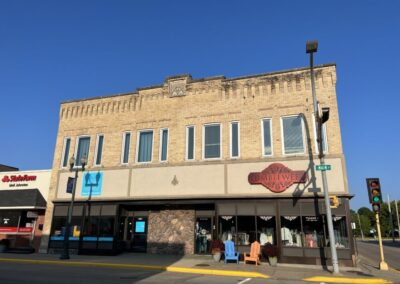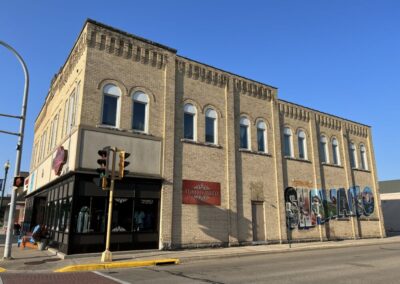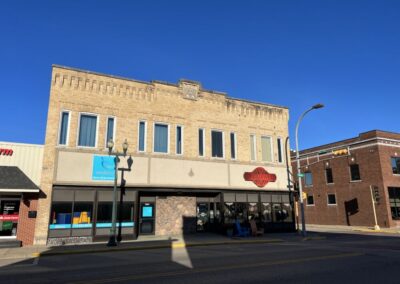Location
Photo Gallery
The Masonic Building at 201-203 S. Main St. in Shawano in 2023. Note the Masonic emblem at the top of the building.
A Brief History
The Masonic Building
201-203 South Main Street
Shawano, Wisconsin
Background of the Shawano Masonic Lodge and the Masonic Block building at 201-203 S. Main Street in Shawano.
Masonry was an established social and moral influence in New York and New England in the middle 1800’s. Many early residents of Shawano had emigrated from these states and several were members of the fraternity. In what must have been late 1866, a petition was presented to the Grand Lodge of Masons of Wisconsin for a dispensation to organize a lodge to be known as “Star of the Frontier.” The dispensation was granted and on February 7, 1867, the first communication was held in a building on the site of the present Dreier Pharmacy. Henry Durtin was named Worshipful Master; Z. Clark Colburn, senior warden; D.H. Pulcifer, junior warden.
A charter was granted to the lodge on June 10, 1868, by the Grand Lodge of Masons of Wisconsin under the name of Shawano Lodge No. 170. Durrin died in April 1868, and Clark Colburn, pastor of the Methodist Church, became the first Worshipful Master. Other men who had brought Masonry to the edge of the wilderness and supported it during its infancy were D.P. Andrews, first junior warden, who was an Indian agent at Keshena; J.E. Breed was a physician; C.W. Bennett, a surveyor; J.L. Hewitt, a farmer – one of the first in the Town of Wescott; Myron McCord, first senior warden, was a lumberman. A.G. Rockwell was a journalist, D.H. Pulcifer was a journalist and a hotel keeper, later post office inspector and the first mayor of the city of Shawano. Jeremiah Slingerland was a teacher and clergyman. Charles Upham was a merchant and private banker. Marion Wescott was a lumberman and county judge. John Wiley was a physician.
The Shawano Lodge has enjoyed four homes, the first in a building owned by Herman Naber (present Dreier pharmacy). From 1876 to 1881 this facility was shared by the Odd Fellows. Then, in turn, the Odd Fellows invited the Lodge to share their new building constructed in 1880 on the site of what was present Senzig TV and Appliance Store. In 1893 the Lodge built its own building which was sold to Chaimson’s in 1919.
The Masonic lodge bought and remodeled the building at on the southwest corner of Division and Main Streets (201 – 203 South Main St.). It was dedicated in June 1922. This ceremony was combined with the fiftieth anniversary celebration which had been postponed because of the war in 1918. Brother Antone Kuckuk was a member of the building committees for both the 1893 and the present one. Shawano Lodge shares these facilities with Shawano Chapter No. 167, Order of the Eastern Star chartered in 1907; Shawano Chapter No. 95, Royal Arch Masons in 1918; Calvary Shrine No. 18; White Shrine of Jerusalem chartered in 1923; and Bethel No. 43, International Order of Job’s Daughters chartered in 1947. The Shawano Masons sold the Main Street building in 2010 and moved Lodge 170 to 2324 East Richmond Street in Shawano.
Since 2010, the building has been used by several businesses.
From the 1999 National Register of Historic Places Registration application:
This building’s two construction dates represent its expansion in order to house the Masonic Temple, following the Lodge’s relocation from another building in 1921. The original, northern portion, which adjoins the corner of Main and Division streets, was extensively remodeled as part of the 1921 addition; the earlier portion can only be discerned in the round-arched windows of the second floor of the north-facing facade and in a slight variation in the color of the bricks of the primary facade. The primary facade has a three-stepped cornice with stone or concrete coping; the central step is inset with a stone bearing the Masonic insignia. The steps immediately to either side of this central step are underscored by a single row of brick corbels; the outlying portions of the facade have double rows of brick corbeling. The second floor of the primary facade is marked by four bays, each with one wider window flanked by two windows approximately one-third the central window’s width. All have original glazing. Each window consists of a single, double-hung, one-over-one window with a transom light above, resulting in markedly long and narrow glazed openings. Each window is surmounted by a lintel of soldiered bricks staggered into a slight arch, which are in turn surmounted by a single horizontal row of slightly projecting bricks. The lintels are of plain stone and extend across all three windows of a given bay. The area between the second floor window sills and the storefront display windows is entirely covered; the storefront itself has no historic features.
The north-facing facade of the building consists of five bays of two openings per floor in each; the bays are delineated by brick piers at equal intervals across the facade. The second floor windows have round-headed arches. They are glazed with one-over-one, double-hung windows with semicircular arched transoms and the two windows of each bay are tied together by a continuous stone sill. The first floor bays consist of single, flat-headed windows and doors; the windows have individual plain stone sills, one-over-one double-hung glazing and are of standard dimensions. The two door openings, one in the second from west bay and one in the second from east bay, have both been altered; the western door has been bricked up to create a small window and the eastern door appears to have replaced a window. This building is visually prominent in the district and has good integrity.




